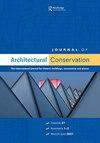Integrating conservation aspects into energy performance assessments for twentieth century buildings: assessing the Canongate Housing complex in Edinburgh, United Kingdom
IF 0.5
3区 艺术学
0 ARCHITECTURE
引用次数: 2
Abstract
ABSTRACT The integration of conservation aspects is rarely considered in energy-related retrofit assessments. Particularly, vulnerable to inappropriate retrofit is the mid-twentieth century heritage, constructed during an era of experimentation with new materials and construction techniques and little regard to energy performance. This paper presents an assessment methodology and its application on a retrofit assessment of the 1960s Canongate Housing complex in Edinburgh, United Kingdom. The aim was to systematically integrate conservation with energy performance, economic feasibility and construction practices. The paper demonstrates that, through production of a Statement of Significance and the identification of character-defining elements, conservation can be integrated into retrofit assessment in the form of a long- and short-listing process. The assessments show that retrofit of technical building systems and renewable-energy generation systems achieves larger reductions than fabric improvement measures and that payback periods can vary substantially for different flat types, leading potentially to diverging interests amongst flat owners.将节能方面纳入20世纪建筑的能源性能评估:评估英国爱丁堡的Canongate住宅综合体
在与能源相关的改造评估中,很少考虑节能方面的整合。尤其容易受到不适当改造的是二十世纪中期的遗产,在新材料和建筑技术的实验时代建造,很少考虑能源性能。本文介绍了一种评估方法及其在20世纪60年代英国爱丁堡Canongate住宅综合体改造评估中的应用。其目的是系统地将节能与能源性能、经济可行性和建筑实践结合起来。本文表明,通过制作“意义声明”和识别特征定义要素,保护可以以长清单和短清单的形式纳入改造评估。评估显示,技术建筑系统和可再生能源发电系统的改造比结构改善措施的减排效果更大,而且不同类型的单位的投资回收期可能有很大差异,这可能导致业主之间的利益分歧。
本文章由计算机程序翻译,如有差异,请以英文原文为准。
求助全文
约1分钟内获得全文
求助全文

 求助内容:
求助内容: 应助结果提醒方式:
应助结果提醒方式:


